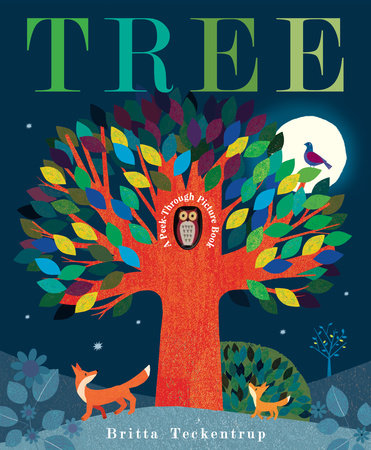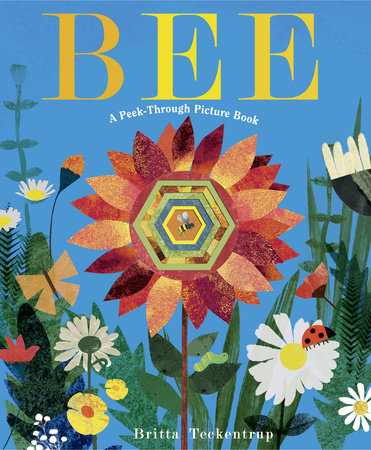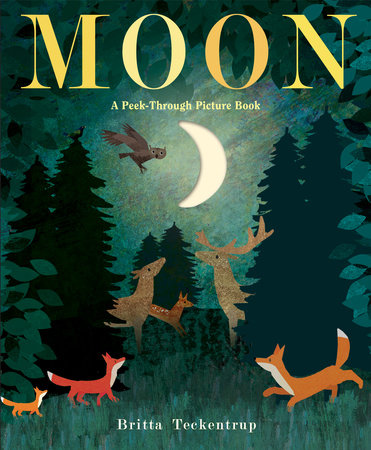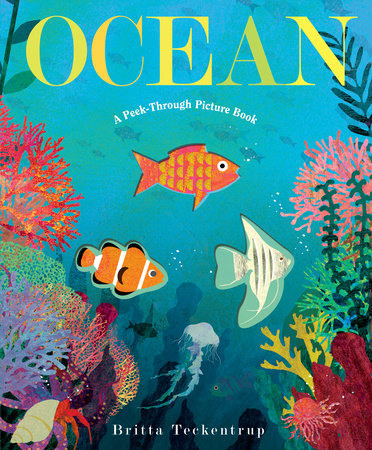5 Reasons to Love the
Peek-Through Picture Book Series
Plus Book-Inspired Activities
by Lindsay Barrett
I’m partial to books that teach children about the world in beautiful ways. The Peek-Through Picture Book series, illustrated by prolific artist Britta Teckentrup, does just that, putting big ideas from nature on dazzling display with its titles Moon, Bee, Tree, and Ocean. Here are five reasons this series is worth a “peek” both at home and in the classroom.
1. They’re works of art.
The quality of both the aesthetic and language in these titles evokes contented sighs. Every detail of the illustrations works in concert, from the textures and colors to the die-cut peek-through details that continue a theme over the course of each book: animals in an apple tree across the seasons, fish darting across an ocean landscape, busy bees pollinating, or the changing view of the moon. And let’s not forget the words! Rhyming informational text can be tricky. It’s easy for rhymes to feel contrived in order to convey a fact. In this series, though, each page’s couplet is pleasing to read aloud and invites children to chime in the last word. There’s plenty of lush vocabulary to bring the scenes to life: foxes don’t run, they “scamper,” and apples don’t fall, they “tumble.”
2. They appeal to a range of ages.
I’ve shared these titles both at home and in classrooms with reliable success. Toddlers are tickled by the view through the tantalizing die-cuts and the opportunities to spot familiar animals. Preschool and kindergarten children eagerly notice the changes on each passing page. Even discerning older elementary children are drawn in by the surprising tidbits of information sprinkled throughout. Did you know that lionfish defend themselves with poisonous spines?
3. You’ll be happy to read them many times over.
In fact, you have to in order to fully appreciate them, because you won’t be able to notice every detail at once. The first time my kids and I read Moon, we were so busy musing about the nighttime activities of the animals on each page that the gradually changing shape of the die-cut moon didn’t even catch our eyes until my son remarked, “Look, it’s a full moon now!” Of course, we had to re-read and focus on the steadily waxing, then waning moon.
4. They stand alone or work as a collection.
When we find a gem of a book in my household, we tend to gather up any titles that accompany it. My children enjoy how some of the animals make an appearance in multiple titles (the inquisitive foxes are a family favorite). They also love comparing the shape and placement of the die-cuts in each book: in Tree, the owl steadily peeks out from its hollow on nearly all the pages, while fish-shaped openings flit every which way on the pages of Ocean.
5. They inspire wonder.
The best informational books help children recall and articulate what they’ve already observed about the world and leave them thirsty for more. My kids and I were all pretty wowed that there’s such a thing as a moonbow (that’s a lunar rainbow, if you were similarly unaware). The ideas that one little bee can be instrumental in helping an entire field of wildflowers bloom, or that little swimmers can arrange themselves into one giant fish-shape to scare predators, are pretty awesome, too.
To that end, the Peek-Through Picture Books are perfect candidates for creative follow-up projects for children. For instance, you and your kids can:
- Keep a moon calendar. Draw how the moon appears each evening (or every few evenings) for a month. Compare observations to the transformation shown in Moon.
- Create a garden collage. Arrange flower cutouts from seed catalogs or gardening magazines on a piece of paper. Add images of busy pollinators and a glittering trail of pollen to finish it off, inspired by the illustrations in Bee.
- Make a mini tree sculpture and decorate it for each season. Choose an interesting branch and poke it through a piece of foam inside a cup or can to create an indoor “tree.” Add seasonal details as shown in Tree, like wisps of cotton for snow, or brightly colored fabric or paper leaves.
- Paint textured fish. Make fish shapes on heavy cardstock and dab them with sponge pieces dipped in paint. (You might also experiment with other tools to create various effects, like balled-up packing paper or squares of bubble wrap.) Allow paint to dry between layers to add details like scales, using Ocean for inspiration.
- Create an original peek-through mini book. Staple a few small squares of paper together and use scissors or a novelty hole-punch (like a star or leaf) to create a shaped opening on all the pages except the final one. Color the shape on the final page so it “peeks” through the rest, and illustrate around it.
-
Get the Books:
-




